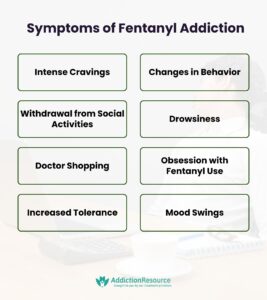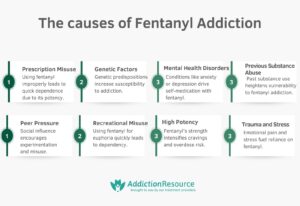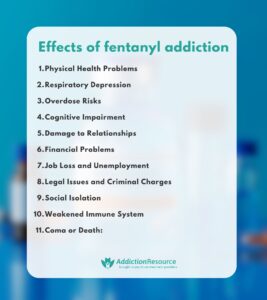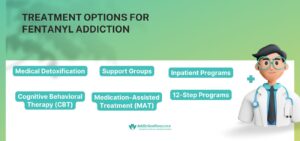Fentanyl Addiction: Definition, Symptoms, Effects, and Treatment
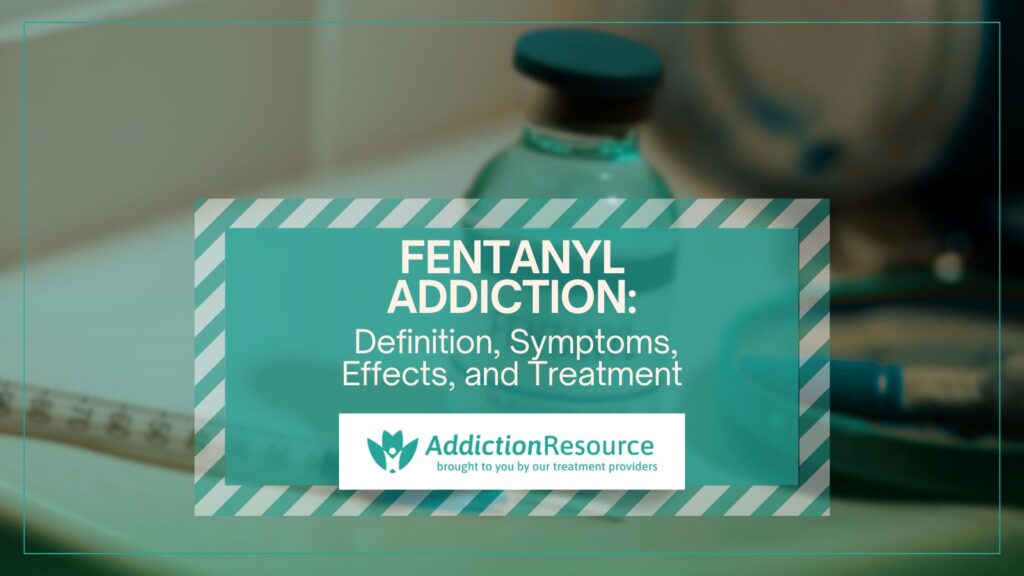
Fentanyl addiction refers to a chronic condition where individuals compulsively use fentanyl, a synthetic opioid up to 100 times stronger than morphine. Fentanyl addiction develops due to medical prescriptions for pain management or illicit use.
The main symptoms of fentanyl addiction include intense cravings, drowsiness, doctor shopping, obsession with fentanyl use, increased tolerance, and mood swings. The main causes of fentanyl addiction are prescription misuse, peer pressure and social influence, recreational misuse, and high potency of fentanyl. The effects of fentanyl addiction are severe, including physical health problems, respiratory depression, overdose risks, and long-term brain changes that impair decision-making.
Table Of Contents:
The treatment options for fentanyl addiction are medical detoxification, cognitive behavioral therapy (CBT), medication-assisted therapy (MAT) using drugs like methadone or buprenorphine, and support groups.
What is Fentanyl Addiction?
Fentanyl addiction is a compulsive need to use fentanyl, a synthetic opioid drug that is highly potent and gives a euphoric high. The DSM-5 classifies opioid use disorder (OUD), including fentanyl addiction, as a problematic pattern of opioid use causing significant impairment or distress. Individuals must show at least two symptoms within 12 months to meet the diagnostic criteria, such as taking larger amounts than intended, unsuccessful attempts to reduce use, and experiencing cravings or withdrawal, according to the “DSM-5 Criteria for Diagnosis of Opioid Use Disorder”.
Fentanyl addiction is a serious public health issue in the U.S., contributing to the ongoing opioid crisis. Provisional CDC data revealed that 73,838 deaths in 2022 were due to fentanyl. Opioids have claimed the lives of over 800,000 Americans between 1999 and 2023, with fentanyl as the most lethal synthetic opioid, according to an article published by USA Facts. Black Americans experienced fentanyl overdose rates of 33.7 deaths per 100,000 in 2022, almost 50% higher than the national average. Black Americans accounted for 21.2% of fentanyl-related deaths despite being only 13.6% of the US population.
What are the Symptoms of Fentanyl Addiction?
The symptoms of fentanyl addiction are intense cravings, changes in behavior, withdrawal from social activities, drowsiness, doctor shopping, obsession with fentanyl use, increased tolerance, and mood swings.
These 8 main symptoms of fentanyl addiction are listed below.
- Intense Cravings: Intense cravings happen when someone feels a powerful and severe urge to use fentanyl, often out of nowhere or in stressful moments. These cravings can take over their thoughts, making it hard to focus on anything else until they use the drug, as stated in the article titled “Fentanyl Drug Facts” published by the National Institute on Drug Abuse.
- Changes in Behavior: People struggling with fentanyl addiction or simply using fentanyl act differently, becoming secretive or avoiding responsibilities, as proved in the case study titled “Behavior change after fentanyl testing at a safe consumption space for women in Northern Mexico: A pilot study” by David Goodman-Meza. Individuals start engaging in risky activities they wouldn’t have before to get or use the drug.
- Withdrawal from Social Activities: Fentanyl addiction leads people to pull away from friends, family, and hobbies. People start skipping important events or stop spending time with loved ones because using the drug becomes their top priority.
- Drowsiness: Drowsiness is a physical symptom that occurs after fentanyl makes people extremely sleepy. Individuals on fentanyl seem out of it, nodding off at odd times, even during conversations, at work, or driving, which becomes dangerous in some situations.
- Doctor Shopping: Doctor shopping is when someone visits multiple doctors to get more fentanyl prescriptions. Doctor shopping is a sign that the person needs more of the drug than before and is desperate to keep using it.
- Obsession with Fentanyl Use: People addicted to fentanyl think about it constantly, such as how to get it, when they’ll use it next, or how they’ll feel after using it. This obsession takes over their life and makes it hard to focus on anything else.
- Increased Tolerance: Increased tolerance means that the body needs more and an increased dosage of fentanyl to feel the same effects over time, according to the article titled “Fentanyl DrugFacts” published by the National Institute on Drug Abuse. What used to be a small dose isn’t enough anymore, which can lead to taking dangerously high amounts to feel relief or euphoria.
- Mood Swings: Mood swings are psychological and range from extreme happiness when using fentanyl to irritability or sadness when the drug wears off. All opioids, including fentanyl, have the potential to cause mood and anxiety symptoms if misused, as stated in the study titled “Mood and Anxiety Symptoms in Persons Taking Prescription Opioids: A Systematic Review with Meta-Analyses of Longitudinal Studies” by Janni Leung and Thomas Santo Jr, published by the National Library of Medicine.
What are the Causes of Fentanyl Addiction?
The causes of fentanyl addiction are prescription misuse, genetic factors, mental health disorders, previous substance abuse, peer pressure and social influence, recreational misuse, high potency of fentanyl, and trauma and stress.
These 8 main causes of fentanyl addiction are listed below.
- Prescription Misuse: Prescription misuse happens when people take fentanyl in ways not prescribed, like taking higher doses or using it more frequently. Prescription misuse quickly leads to dependence, especially since fentanyl is a highly potent opioid used to treat severe pain.
- Genetic Factors: Genetic factors play a role in addictions, including fentanyl addiction, as some people are more biologically prone to substance abuse. The study titled “New NIH study reveals shared genetic markers underlying substance use disorders” published by the National Institute on Drug Abuse shows that genetics influence how a person’s brain responds to opioids, increasing the chances of addiction if exposed.
- Mental Health Disorders: Mental health disorders like anxiety, depression, or PTSD increase the risk of fentanyl addiction. People turn to fentanyl as a way to self-medicate and find temporary relief from emotional pain, which quickly leads to addiction.
- Previous Substance Abuse: Having a history of substance abuse, such as using other opioids or alcohol, increases the risk of becoming addicted to fentanyl. The brain’s previous exposure to addictive substances makes it more vulnerable to the powerful effects of fentanyl.
- Peer Pressure and Social Influence: Peer pressure and social influence push people toward fentanyl use, especially in social settings where drugs and fentanyl use are normalized. The desire to fit in or avoid rejection leads people to experiment with fentanyl.
- Recreational Misuse: Recreational misuse involves using fentanyl for the euphoric high rather than for medical reasons. Recreational and street use of fentanyl combined with other illicit drugs is a growing concern in the US, as proved in the 2019 study titled “Street fentanyl use: Experiences, preferences, and concordance between self-reports and urine toxicology” by Raminta Daniulaityte and Robert R. Carlson. Even occasional recreational use of fentanyl quickly leads to dependency and addiction because of its potency.
- High Potency of Fentanyl: Fentanyl’s high potency, which is up to 50 times stronger than heroin, makes it extremely addictive. Even small doses cause powerful effects and lead users to crave more, increasing the risk of overdose with repeated use.
- Trauma and Stress: Trauma and stress, whether from childhood experiences, abuse, or life challenges, are significant risk factors for fentanyl addiction. People use fentanyl as a coping mechanism to avoid their feelings and numb emotional pain, creating a cycle of dependency.
Hope Without Commitment
Find the best treatment options. Call our free and confidential helpline
Most private insurances accepted
What are the Effects of Fentanyl Addiction?
The effects of fentanyl addiction are physical health problems, respiratory depression, overdose risks, cognitive impairment, damage to relationships, financial problems, job loss and unemployment, legal issues and criminal charges, social isolation, weakened immune system, and coma or death.
These 11 main effects of fentanyl addiction are listed below.
- Physical Health Problems: Physical health problems are a direct result of fentanyl addiction, including chronic fatigue, muscle pain, and weakened organ function, as stated in the article titled “Fentanyl” published by the Government of Canada. Prolonged use leads to gastrointestinal issues and severe weight loss that damages the body’s strength.
- Respiratory Depression: Respiratory depression occurs when fentanyl slows breathing to dangerously low levels, sometimes to the point of stopping completely, as stated in the research titled “Fentanyl depression of respiration: Comparison with heroin and morphine” by Rob Hill and Rakulan Santhakumar.
- Overdose Risks: Overdose risks are extremely high with fentanyl because of its potency, which is up to 100 times stronger than heroin, according to the article titled “What is fentanyl?” published by the National Institute on Drug Abuse. A small miscalculation in dose results in life-threatening conditions such as unconsciousness, cardiac arrest, or death.
- Cognitive Impairment: Cognitive impairment from fentanyl use includes memory loss, confusion, and difficulty focusing. Individuals who use heroin or fentanyl are 2.21 times more likely to experience cognitive impairment compared to those who do not use opioids, as stated in the study titled “Cognitive Impairment Among People Who Use Heroin and Fentanyl: Findings from the Miami Adult Studies on HIV (MASH) Cohort” by Javier A Tamargo and Adriana Campa.
- Damage to Relationships: Damage to relationships happens as fentanyl addiction strains connections with loved ones. Addicts focus more on fentanyl and neglect personal relationships, leading to conflicts, isolation, and breakdowns in family and social bonds.
- Financial Problems: Financial problems arise as addicts prioritize buying fentanyl over essential expenses. Users face mounting debt, loss of savings, and even homelessness due to the high costs associated with their addiction.
- Job Loss and Unemployment: Job loss and unemployment result from reduced productivity and behavioral changes caused by addiction. Fentanyl users face financial strain and difficulty in maintaining stability without employment.
- Legal Issues and Criminal Charges: Legal issues and criminal charges occur as users engage in illegal activities like theft or drug possession to fund their fentanyl addiction. Arrests and convictions further complicate the process.
- Social Isolation: Social isolation happens when users withdraw from friends, family, and social activities and focus only on their fentanyl use. This isolation deepens feelings of loneliness, shame, and guilt.
- Weakened Immune System: A weakened immune system leaves fentanyl users more prone to infections and chronic illnesses. Poor nutrition, sleep deprivation, and fentanyl’s toxic effects contribute to a compromised immune response, according to the study titled “Do All Opioid Drugs Share the Same Immunomodulatory Properties? A Review From Animal and Human Studies” by Silvia Franchi.
- Coma or Death: Coma or death results from even a single fentanyl overdose. Fentanyl overdose causes irreversible damage or fatal outcomes without immediate medical help.
How is Fentanyl Addiction Diagnosed?
Fentanyl addiction is diagnosed by evaluating a person’s physical health, behavior, and history of opioid use. Healthcare providers begin with a detailed assessment that includes discussion of symptoms such as intense cravings, withdrawal symptoms, and changes in daily functioning. They use the criteria outlined in the Diagnostic and Statistical Manual of Mental Disorders (DSM-5), which identifies key signs like increased tolerance, failed attempts to quit, and continued use despite harmful consequences. Medical tests, such as blood or urine screenings, detect fentanyl use and confirm substance presence in the body. Mental health evaluations are conducted to identify co-occurring disorders like anxiety or depression.
What are the Treatment Options for Fentanyl Addiction?
The treatment options for fentanyl addiction are medical detoxification, cognitive behavioral therapy (CBT), medication-assisted therapy (MAT), support groups, inpatient programs, and 12-step programs.
These 6 treatment options for fentanyl addiction are listed below.
- Medical Detoxification: Medical detoxification is the process of safely removing fentanyl from the body under medical supervision. Medical detoxification helps manage withdrawal symptoms for opioid addiction, including fentanyl addiction, such nausea, sweating, and severe cravings, according to the article titled “Treating opiate addiction, Part I: Detoxification and maintenance” published by the Harvard Medical School.
- Cognitive Behavioral Therapy (CBT): Cognitive Behavioral Therapy (CBT) focuses on identifying and changing harmful thought patterns that lead to substance use disorders, including fentanyl addiction, according to the study titled “Cognitive-Behavioral Therapy for Substance Use Disorders” by R Kathryn McHugh, Bridget A Hearon, and Michael W Otto. Individuals learn coping strategies through CBT to handle triggers and stress of addiction.
- Medication-Assisted Treatment (MAT): Medication-assisted treatment (MAT) combines medications like buprenorphine, methadone, or naltrexone with counseling. Buprenorphine, methadone, and naltrexone help reduce cravings and withdrawal symptoms of fentanyl addiction, making it easier for patients to focus on behavioral therapies and recovery, as stated in the article titled “Fentanyl Drug Facts” published by the National Institutes on Drug Abuse.
- Support Groups: Support groups offer a safe and friendly environment where individuals share experiences and encouragement with other people going through the same condition, such as fentanyl addiction. Support groups provide emotional support and motivation for those working to get clean and sober.
- Inpatient Programs: Inpatient programs require individuals to live in a treatment facility for a fixed time period, usually 30 to 90 days. Inpatient programs provide 24/7 medical care, structured therapy sessions, and a safe environment free from triggers.
- 12-Step Programs: 12-step programs guide individuals through a series of spiritual and personal growth steps to overcome their fentanyl addiction. Participants work with a sponsor and follow a structured plan that involves learning about accountability, healing, self-reflection, and support throughout the recovery journey.
What is Fentanyl?
Fentanyl is a powerful FDA-approved synthetic opioid for pain management, particularly in cases of severe pain such as advanced cancer or post-surgical pain, according to the research titled “Fentanyl” published by the National Institute on Drug Abuse. Fentanyl is up to 100 times stronger than morphine and 50 times more potent than heroin, making it highly effective but extremely dangerous. Fentanyl is prescribed in forms like transdermal patches, lozenges, or injections in medical settings for managing acute and chronic pain. Fentanyl plays an important role in treating intense pain, but its misuse leads to severe addiction and overdose or death in some cases.
Why is fentanyl addictive?
Fentanyl is addictive due to its potency (50 – 100 times stronger than morphine) and rapid action on the brain’s opioid receptors. Fentanyl produces an intense surge of dopamine and creates euphoria and deep relaxation. This rapid dopamine release triggers dependence after just a few uses. Users feel compelled to use fentanyl more frequently because it acts quickly and leaves the system faster than other opioids.
How is fentanyl consumed?
Fentanyl is consumed through various methods, including lozenges, skin patches, injections, tablets, and mouth sprays. Fentanyl is administered medically via lozenges on a stick (Actiq) for cancer pain, skin patches (Fentora) for chronic pain, and injections or IV (Sublimaze) for surgical anesthesia. Other forms include sublingual tablets (Abstral), mouth sprays (Subsys), and nasal sprays (Lazanda). Fentanyl is found as counterfeit pills or mixed with heroin or cocaine in illegal recreational settings.
How does fentanyl make you feel?
Fentanyl makes you feel intense euphoria, relaxation, and pain relief. Fentanyl interacts with the brain’s opioid receptors and reduces the signs of pain while triggering a flood of dopamine that gives happiness. The high of fentanyl is short and leads to users repeatedly consuming the drug to maintain the high. Users may experience dizziness, drowsiness, and confusion alongside euphoria.
How long does fentanyl stay in your system?
Fentanyl stays in the system for 12 hours to 3 months, depending on the testing method. Fentanyl is detected in blood for up to 12 hours after use. Fentanyl remains detectable for 24 to 72 hours in urine, depending on the dose and frequency of use. Hair follicle tests detect fentanyl for up to three months. Individual factors such as metabolism, body mass, and overall health influences how long fentanyl stays in the system.
What is fentanyl withdrawal?
Fentanyl withdrawal occurs when someone who is physically dependent on the drug stops using it. The symptoms of fentanyl withdrawal begin within 12 to 30 hours after the last dose and include intense cravings, muscle aches, sweating, anxiety, insomnia, and nausea. Withdrawal is more severe than with other opioids due to fentanyl’s high potency.
Can fentanyl use lead to overdose?
Yes, fentanyl use can lead to overdose due to its extreme potency. Even a small amount of the drug increases the chances of a fentanyl overdose, especially when mixed with other substances. Approximately 73,838 overdose deaths were reported in the US in 2022, involving synthetic opioids, mainly illicitly manufactured fentanyl, according to the “Drug Overdose Deaths: Facts and Figures” published by the National Institute on Drug Abuse.
How much stronger is heroin than fentanyl?
Fentanyl is approximately 50 times stronger than heroin. Even a tiny dose of fentanyl causes effects similar to a much larger amount of heroin. Users of heroin who unknowingly consume fentanyl are at a high risk of overdose.
Is fentanyl associated with a higher risk of overdose compared to methadone?
Yes, fentanyl is associated with a higher risk of overdose compared to methadone. Methadone is used in controlled medical settings to treat opioid addiction and has a slower time of causing effects, making it less likely to cause sudden overdose. Fentanyl has a quick absorption rate and is extremely potent, increasing the chance of overdose, especially when used illicitly.
Is mixing meth and fentanyl dangerous?
Yes, mixing meth and fentanyl is extremely dangerous. Meth is a stimulant, while fentanyl is a depressant, and the combination masks the effects of one another, delaying signs of overdose. This dangerous interaction increases the risk of fatal respiratory failure and cardiovascular issues. The combined impact on the heart and lungs makes the combination of meth and fentanyl one of the most lethal drug combinations reported in overdose cases.
Hope Without Commitment
Find the best treatment options. Call our free and confidential helpline
Most private insurances accepted


